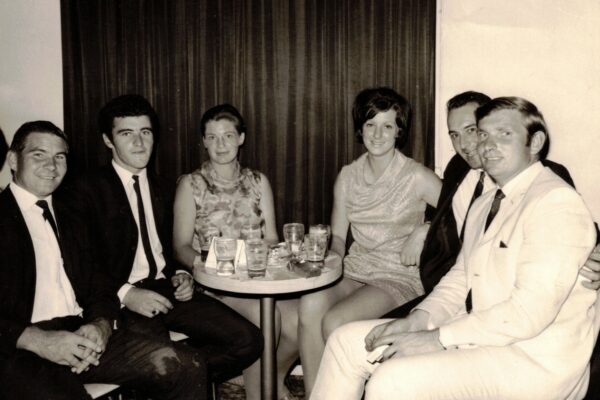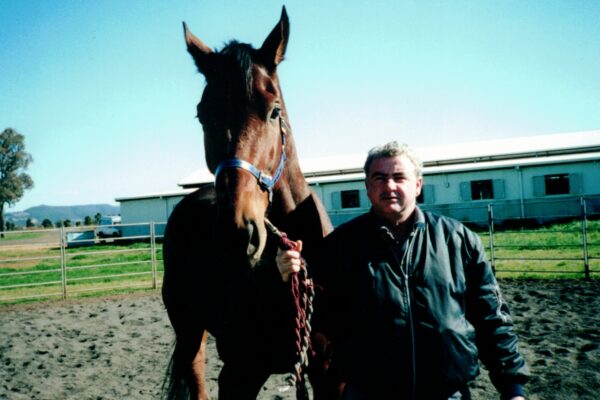Featured Image: ‘Cetigne’ at Mr T. A. Stirton’s Dunlop Stud at Merriwa NSW from a painting of the horse by Martin Stainforth when aged seven years.
‘Cetigne’ (29): Bay Horse 1912 by ‘Grafton’ (imp.) ex ‘Pretty Nell’
‘Cetigne’ was the winner of £27,216 and at the time second on the list of winning Australian racehorses. He was retired to stud in 1921 to Mr T A Stirton’s ‘Dunlop Stud’ at Merriwa. This is a scenario which has almost completely evaporated one hundred years later. Merriwa used to be a very fertile and productive area for thoroughbred production with several wealthy graziers and pastoralists strongly supporting the industry. Arthur Wright is the only relict of this once vibrant locale. Members of the Stirton family are still around the area but no longer involved in raising horses.
Ian Ibbett has written a stirring account of ‘Cetigne’s’ emergence as an outstanding racehorses of the early 1900s including his win in the 1915 AJC Derby.
See: http://kingsoftheturf.com/1915-ernie-green-albert-wood-and-cetigne/
Cetigne was finally retired from racing after the A.J.C. Autumn Meeting in 1921, his final appearance being an unplaced effort behind Speciality in the All-Aged Stakes. The inducement that had kept Cetigne in training beyond the age of most stallions – that of eclipsing Carbine’s record stakes – had proved beyond him after all. For thirty years Carbine’s record of £29,476 had stood supreme. Cetigne made a gallant but ultimately unsuccessful attempt at it. Perhaps with a little more luck in his last two seasons on the Turf he might have done it. When he did finally retire, he had won £27,216 from eighty-one starts. Though fast he could not stay beyond a mile and a half, and he was probably at his best in a fast-run mile. At one time he held two Australian time records; over ten furlongs in that famous Craven Plate, and over the mile established at Flemington in the 1919 running of the Linlithgow Stakes at 1 minute 37 seconds.
A curious feature of his racecourse career was that from the time he began racing as a two-year-old in the spring of 1914, he ran at Flemington on Derby Day for seven successive years variously finishing unplaced in the Maribyrnong Plate, second in the Derby and twice winning the Melbourne Stakes. It was risky to run him as a seven-year-old stallion twice in the one day at the V.R.C. Autumn Meeting in 1920 and many suspected it affected him afterwards. That day he went within a length of winning his second Newmarket with 9 st. 6lb and two races later came out to win the valuable weight-for-age Essendon Stakes. Although that second venture was successful, it was at the expense of his chance of reaching Carbine’s stakes total. Still, even as an eight-year-old, he remained capable of a bravura performance, as he showed in the Villiers Stakes at Randwick, when with 9 st. 8lb he was unlucky to be beaten a neck into second place.
Cetigne was retired to Tom Stirton’s Dunlop Stud at Merriwa, NSW at a fee of fifty guineas. Apart from Sylvanite, Cetigne was the only first-class son of Grafton to get into a stud of thoroughbred mares. Stockbreeders from the Gulf to Adelaide were very much taken with the power and strength of Grafton’s sons, and they were quickly snapped up as general station sires, while a few of his good sons were rushed by Indian buyers, notably FitzGrafton and Tangaroa and Cadonia, of course, which finished in Germany. So, there was much interest in Cetigne’s career at stud. He did let down into a magnificent specimen and in 1922 was crowned the premier blood horse at the Sydney Easter Show. Alas, his exploits in the breeding barn did not match his appearances in the show ring. Cetigne’s only principal winner proved to be the Western Australian galloper, Cetotis, who twice won the W.A.T.C. All-Aged Stakes.










